Purple martins are a bird of the people.
Throughout most of their range, martins are completely dependent on human-created nesting structures. Even beyond the nesting season, purple martins commonly establish roost sites in and around human-created structures.
It’s not clear when martins made the switch from natural nesting cavities to human-constructed purple martin houses.
Many writers suggest that Native Americans built purple martin houses and that the switch to human-made housing was underway before the arrival of Europeans in North America. Although this is entirely plausible, there isn’t much evidence that Native Americans are responsible for the bird’s transition from natural to human-made nest sites.
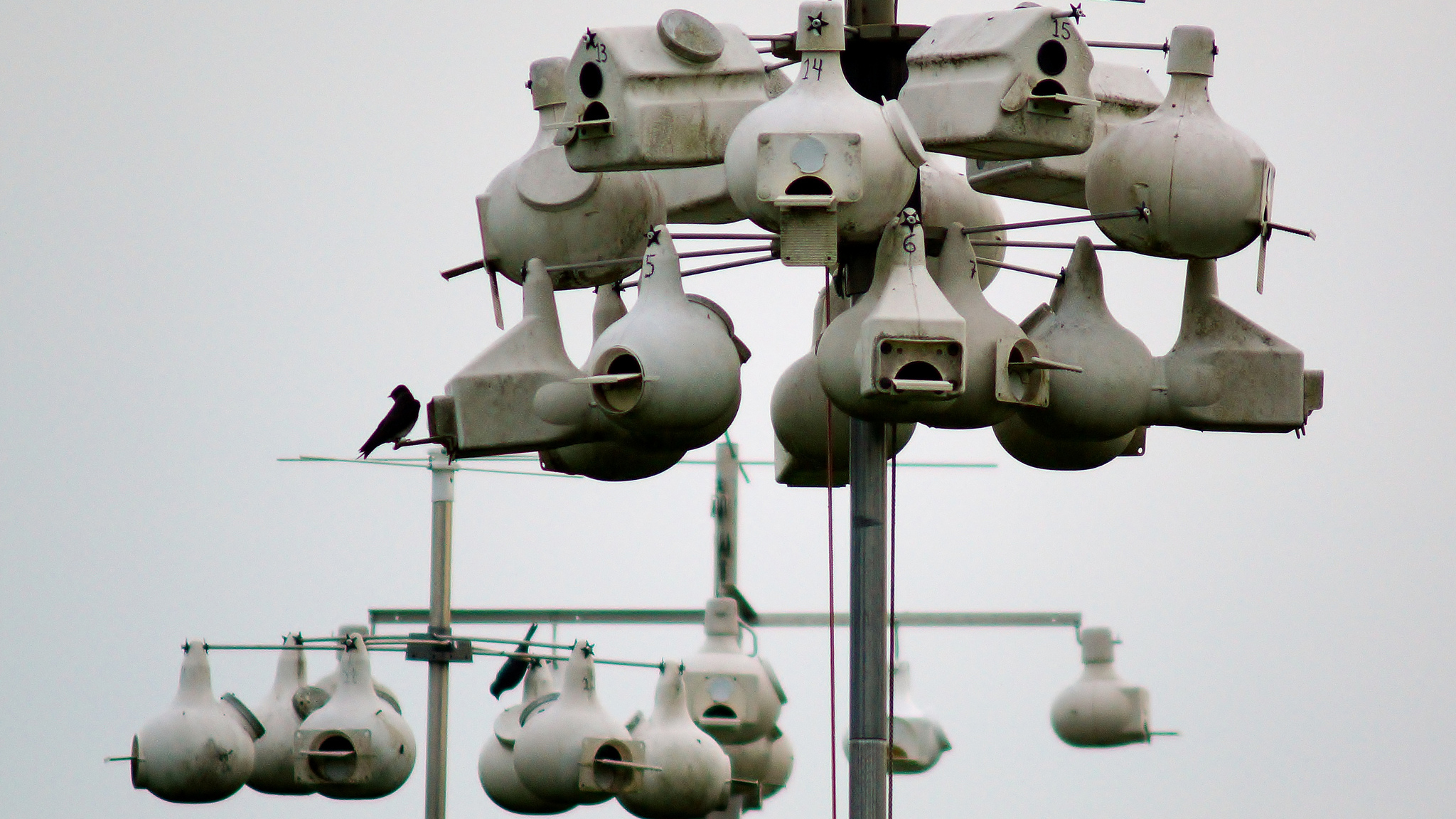
Early American ornithologists did mention seeing Native American-built gourd houses. But they made these observations well after Europeans settled in North America.
In his book American Ornithology (1808), Alexander Wilson implies that while visiting Choctaw and Chickasaw settlements during the late 1700s, he saw hollowed-out gourds for purple martins placed atop poles.
Even in the early 1700s, naturalist Mark Catesby noted that martin houses were a common sight in colonial farms and towns in the Carolinas.
By the time Wilson and Catesby made their observations, everyone had martin houses.
Should We Rename Them People Martins?
Equally unclear is why people became interested in providing martins a home.
Some potential benefits offered by early observers are that the birds reduced the general bugginess around human habitation and that the martins protected barnyard fowl by mobbing and chasing hawks.
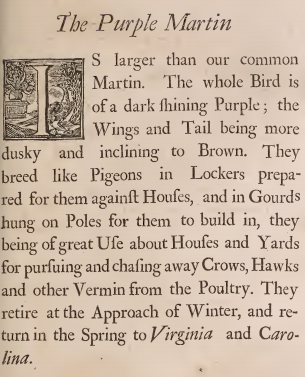
The popularity of providing homes for martins in modern times may stem from the mistaken belief that they are effective at controlling mosquitoes.
A dubious factoid, stated and restated over decades, asserts that, “a single martin eats 2,000 mosquitoes per day.”
Herbert Kale set the record straight in his 1968 article in the journal The Auk, demonstrating that there was no evidence that purple martins eat very many mosquitoes.
He pinned the blame for the false factoid on J.L. Wade, a businessman who “made a fortune building pole-top condominiums for purple martins.”
According to his 2007 obituary in the Wall Street Journal, Wade was so fond of the “2,000 mosquitoes” claim that he changed the last four digits of his phone number to “2000.” Despite false advertising, Wade is remembered as a tireless advocate for purple martins (and for martin houses!).
What do martins really eat? Everything but mosquitos, it seems. They eat a wide variety of larger-flying insects including beetles, flies, dragonflies, grasshoppers, wasps and bees.
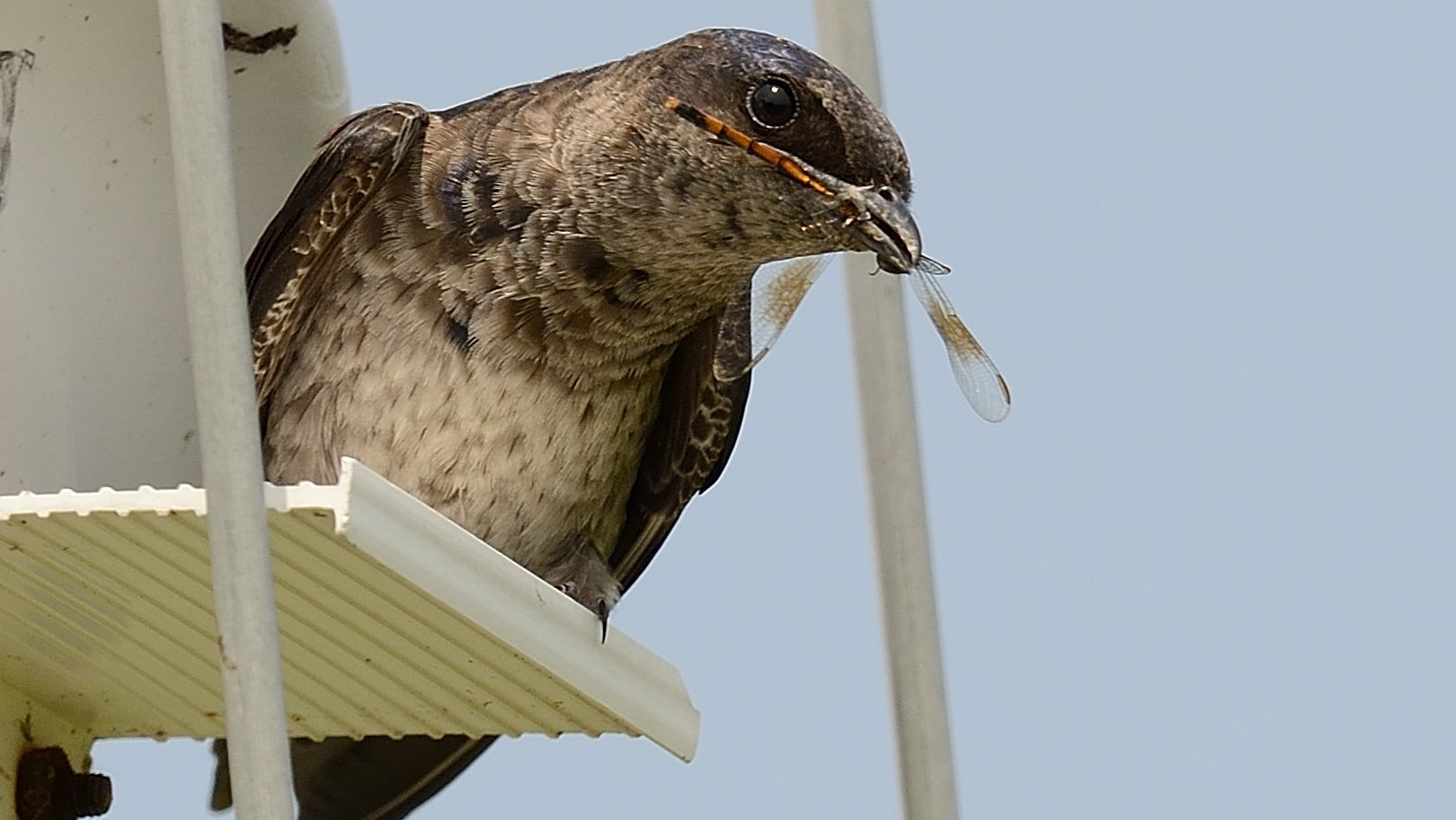
Recent research has revealed that martins do provide an important insect control service after all. They hoover up as many flying fire ant queens as they can. A 2016 study revealed that fire ants comprise 56% of all items consumed by martins at study site in Oklahoma.
Fire ants were introduced from South America and are now common throughout the southeast United States. Among other undesirable attributes, fire ants build mounds that dot lawns, fields and pastures. Whenever a mound is disturbed, the ants attack en masse with painful stings.
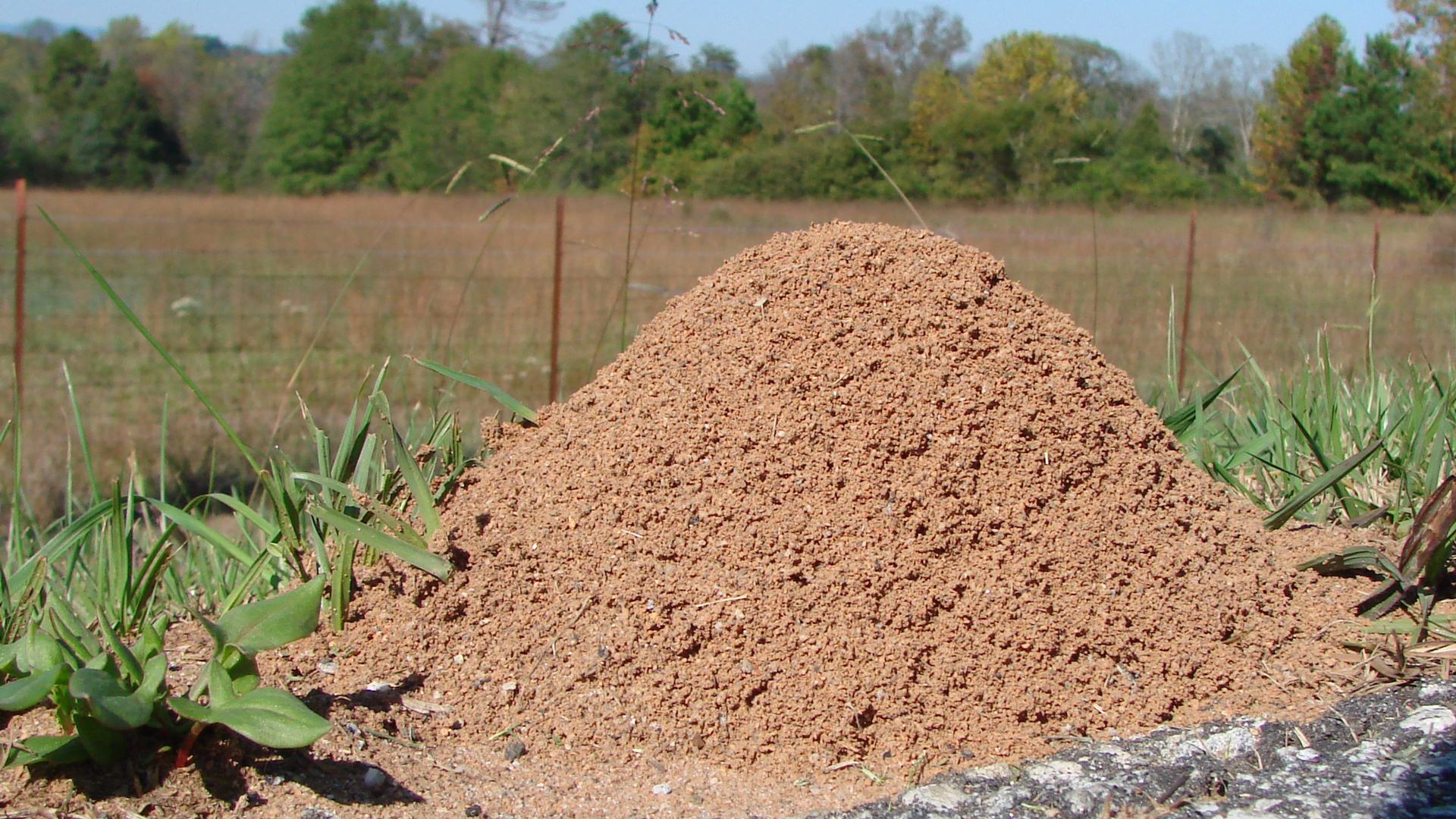
Each queen a purple martin scarfs up means one less pestilential mound of cranky ants on the lawns of Dixie.
Urban Martins
Beyond the nesting season, purple martins remain a bird of the people.
After nesting and prior to migrating, thousands of martins gather to roost in such places as bridges, powerline structures and trees in parking lots, along with locations in more natural settings.
Roosts are a dramatic and easily observable wildlife spectacle in mid to late summer – especially at dusk when the birds arrive and whoosh by the thousands into the roost site. If you live in the eastern U.S. it’s very likely that one of these roosts is close by. Check this map of roost sites, courtesy of the Purple Martin Conservation Association.
In 1903, P.A. Taverner described a roost in Chicago that formed at the corner of Washington Square Park. He writes that “in all of Chicago, I know of no spot that would seem more unlikely to be used for such a purpose.” He goes on to describe the scene:
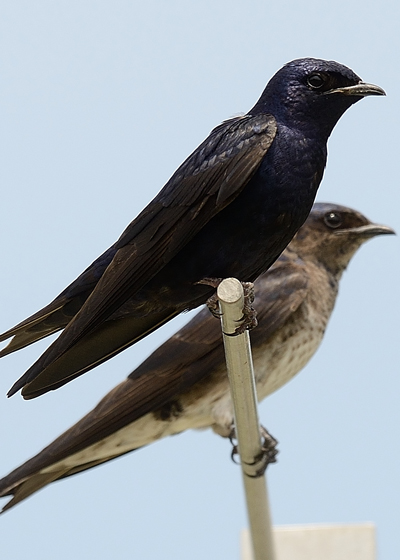
“On the avenue is a double line of noisy, clanging, banging cable cars, running a three-minute service. Diagonally across there were a number of pop-corn stands, gypsy fortune tellers with their array of gasoline jacks and the usual quota of loafers. Automobiles, delivery wagons, trucks, and all manner of vehicles are continually passing, and the street is generally well filled evenings, with a throng of saunterers, sightseers and loafers.”
Purple martins seem almost attracted to people. Even after migration to Brazil, where most purple martins spend the winter, their habit of roosting in and around human-made structures continues.
David Attenborough profiled such behavior in the The Life of Birds documentary series. He shows that even in the heart of the Amazon rainforest, the martins chose to roost in an oil refinery.
Throughout Brazil, martins frequently roost in cities and towns. But this behavior doesn’t seem to be as celebrated in Brazil as it is in the U.S.
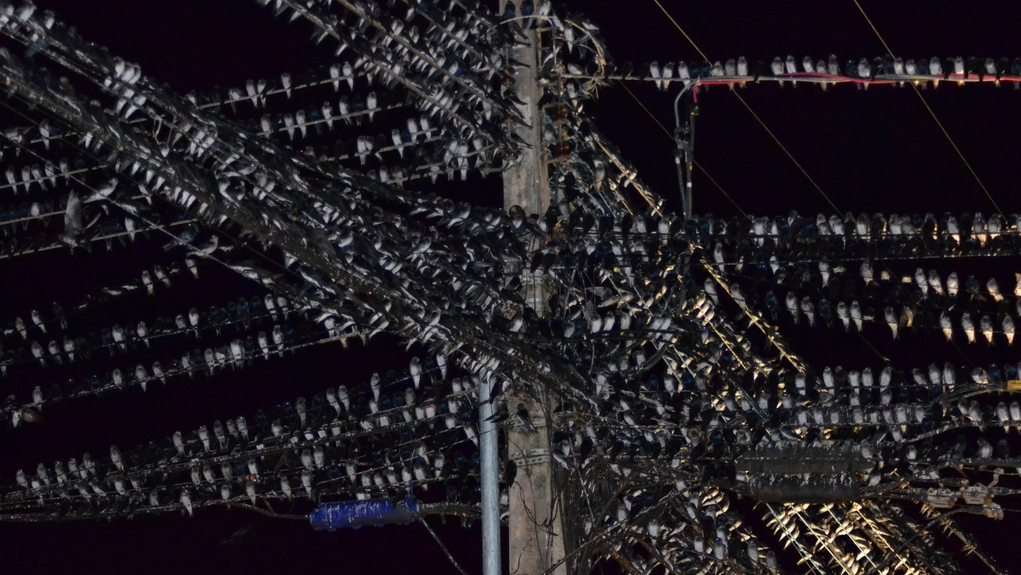
The difference in perspective is related to time scale.
In the United States, big communal roosts of martins are ephemeral, lasting only for a few weeks in the period prior to migration.
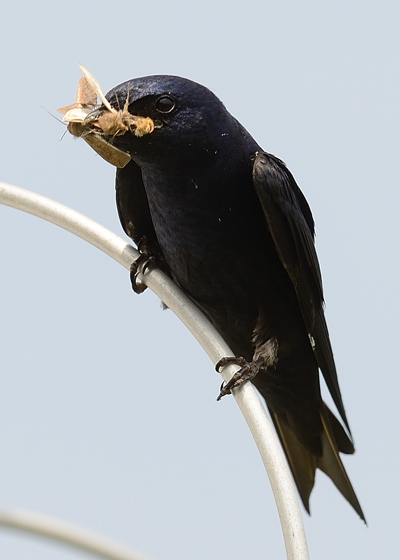
But in Brazil, the roosts can last for six months. Imagine six months’ worth of nightly excrement production from thousands of birds. Too much of a good thing can become a perplexing public nuisance.
News reports talk of municipalities needing dump trucks to haul away the excrement and feathers that accumulate over the course of months.
The toll that martins take on a public park can be seen in this Brazilian news video.
The people being interviewed (understandably) complain of the sight and smell of a city park piled high with bird dung. A researcher muses on the public health risk of the bird waste and the commentator wonders if there isn’t a way to scare the purple martins off to make them move to another location.
In another Brazilian city 600 miles away, the same problem and the same complaints are profiled. This report is more balanced, with the commentator expressing wonder at the spectacle of thousands of birds arriving from far off places.
In yet another news story, there are reports of ruined car paint and a schoolyard polluted with martin poo. The local government promises solutions.
Out of the sight and minds of its fans in North America, the purple martin faces a public relations problem in South America. Some people there wish the birds didn’t have such a great affinity for towns and cities.
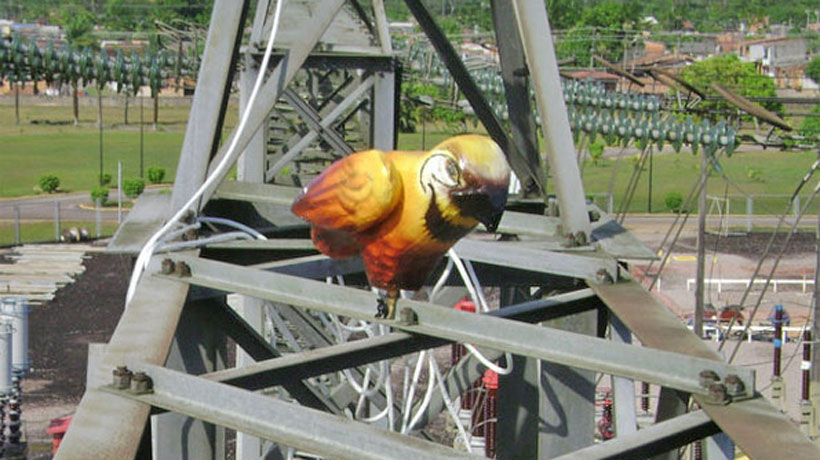
Martin Conservation Goes Beyond Bird Houses
Divergent perspectives regarding purple martins between North and South America remind us that conservation of migratory birds needs to take full view of their life cycle. It seems important to know what proportion of Brazilian martin roosts occur in places that cause problems for people. This is especially true if some of these roosts are being disturbed out of sanitation concerns. In that case, we also need to know what impact roost disturbance has on martin populations. As in the United States, purple martins are protected by federal law but indirect actions are permitted to discourage roosting, such as erecting scarecrows or exclusion netting.
Although we continue to learn more and more about the lives of purple martins, big questions remain unanswered. How did our own cultural practice of building martin houses emerge and how did martins become so utterly dependent on us? And what benefits are gained for purple martins by cozying up to roost in powerlines, refineries and city parks?
Purple martins are among our most studied and beloved backyard birds, and yet the reasons behind their unfaltering affinity for the human landscape remains a great mystery.
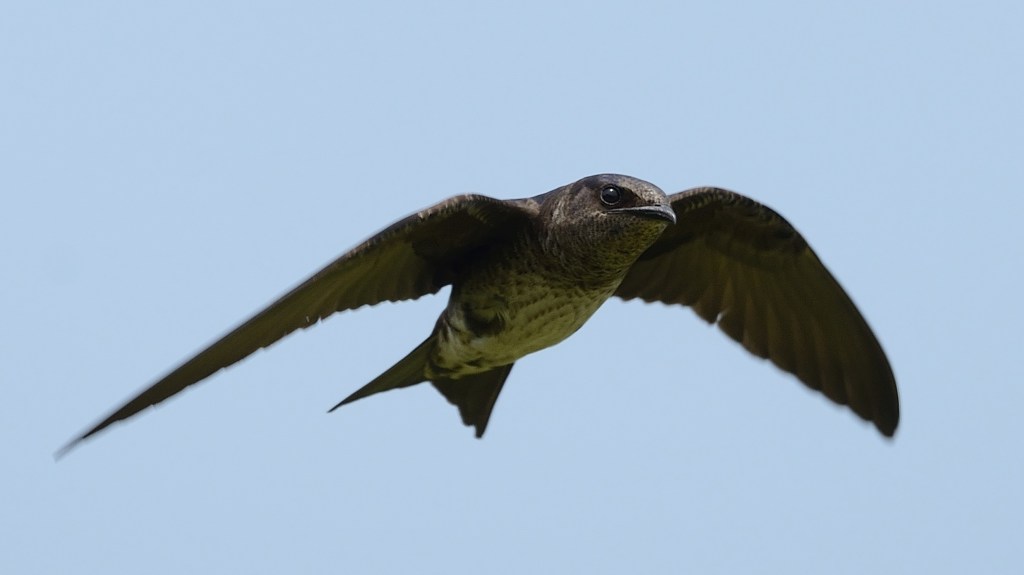



Joe,
Can you please tell me if the Purple Martin is specifically protected in Texas or do you have to go through the US Fish and Wildlife? My sisters neighbor has been harassing her due to the erection of thier 24 gourd purple Martin housing. They are trying to Sue them through the city. As I have read they are specifically protected in the State of Texas.
Thank you very much,
Any additional information would be most helpful.
Jennifer Church
(425)314-7050
Hi Jennifer, Thank you for the question! TPWD would be the best place to find out about Texas-specific regulation on Purple Martins: https://www2.tpwd.state.tx.us/business/feedback/webcomment/
What about all the natural cavity nesters in the western subspecies population! Let’s not forget about them! There are small colonies of purple martins nesting in natural snag cavities scattered throughout upland forest in Oregon (and probably WA and BC as well), as well as birds nesting in natural rock crevices in northern Cali and saquaro cacti in Arizona.
Hi Nancy, the abandonment of previously successful colony site suggests a possible predator problem. Purple Martins have what is called site fidelity, meaning the return to a previous successful colony. If your colony was attacked by a predator, they will likely not return. Predators on colony’s include racoons, snakes, hawks and owls. Here is a link to a page from the Purple Martin Conservation Association website which talks about predators and what we can do to protect the martins. Read especially the pdf on pole guards, https://www.purplemartin.org/purple-martins/managing/55/predators/
Thanks for your article Joe. Years ago there were purple martins in Southern California – not so recently. What conditions might bring them back? If they returned, would they become a non-migratory population as some Monarch butterflies?
I want to help
You might be interested in Project MartinWatch, run by the Purple Martin Conservation Association: https://www.purplemartin.org/research/18/project-martinwatch/
Thanks for all of the terrific comments! For those of you curious about how to get started with attracting purple martins, a great resource is the Purple Martin Conservation Association website.
They have a page on getting started and also an FAQ page that discusses some of challenges of attracting and keeping purple martin colonies.
https://www.purplemartin.org/education/75/getting-started/
https://www.purplemartin.org/education/24/faq/
Maybe the martins think they are domesticating us. Recently, several paleontologists have reinterpreted the findings in ancient cave sites to suggest that dogs domesticated humans, welcoming them to their dry, warm dens, rather than the other way around. Similar rethinking has been attempted with cats. It seems quite likely that dogs and cats gained a lot more from having human staff than humans gained. Cats, especially, have been transplanted world-wide and are thriving, often at the expense of the local wildlife, who have no experience with this apex predator.
I love and want to help all Gods animals all over this world.
What do you suggest we should do to help?
All of our wildlife deserve protection before we wipe them out and cannot get them back.
It has been many years since I have seen Purple Martins in the Minneapolis, Minnesota area where I live. In fact the only flock of swallows I have seen this fall was a flock of Bank Swallows on top of a building twittering.
Please invest in the future of the spectacular bird.
The Billy Frank Jr. Nisqually National Wildlife Refuge ‘s September Flyway newsletter reported Purple Martins nesting in a restoration snag. I can’t figure out how to upload the article, but maybe you can contact the Billy Frank Jr. Nisqually National Wildlife Refuge for a copy. This is on the Puget Sound in Washington State.
all wildlife must be protected
Living outside of Augusta, GA, we put out a purple martin house each spring. We have been doing this for the last five years and have yet to have a purple martin visit and/or nest in it. We have yet to figure out why they are not coming to the house. Other people in Augusta are having success. Any suggestions?